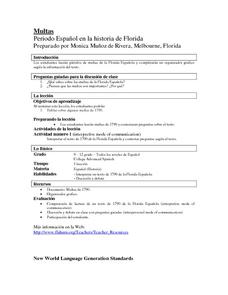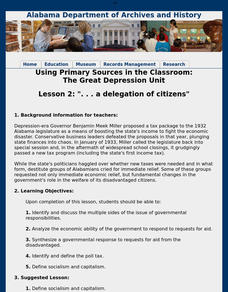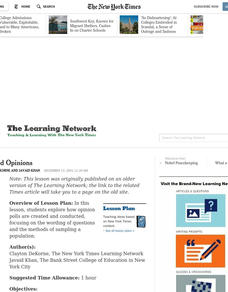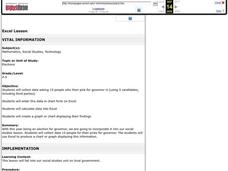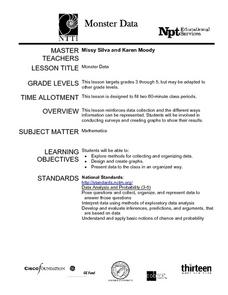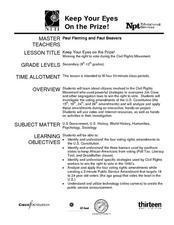Curated OER
Amnesty: More Than a Word
High schoolers explain how the use of certain emotive terms affects voter's perceptions. Students assess how word choice by political parties can changes our thinking on a subject. After viewing ads by the two political parties, high...
Curated OER
Multas
Combine history and Spanish instruction with an exploration of descriptions of fines given in Florida in 1790. Partners read the brief text, fill out a graphic organizer about the crimes described, and interview each other about fines....
Curated OER
Lesson 2: ". . . a delegation of citizens"
Young scholars define socialism, capitalism and poll tax. They identify and discuss the multiple sides of the issue of governmental responsibilities.
Curated OER
Painting versus Photography
High schoolers consider the nature of objectivity and subjectivity in photography as an art form by taking a class poll, discussing the results and writing a one-page paper.
Macmillan Education
Organising Your Studies
What's the best way to study? Well, it depends. . . Session two of a 23-lesson life skills series focuses on a variety of study skills strategies and suggests when/why to choose one over another.
PBS
From Selma to Montgomery: An Introduction to the 1965 Marches
The 1965 Civil Rights marches from Selma to Montgomery and the resulting Voting Rights Act of 1965 are the focus of a social studies lesson. The resource uses film clips to inform viewers not only about the discrimination that gave rise...
Curated OER
Play Ball: A Major League Review Game
In this review and test-taking practice lesson plan, the classroom is set up like a baseball field. The class is set up into 2 teams and has to answer questions that moves them along the bases like in baseball. The team that wins has the...
Curated OER
Street Cows
A light, and humorous lesson on "street cows" is here for you. Learners listen to the story, "Street Cows," which is embedded in the plan. On a map of the US and the World, they locate the cities where the "Cows on Parade" exhibit was...
Curated OER
Measured Opinions
Students read "Public Is Wary but Supportive on Rights Curbs," at the New York Times online. They explore how opinion polls are created and conducted, focusing on the wording of questions and the methods of sampling a population.
Curated OER
Excel Lesson
Students explore data and Excel spreadsheets. They collect data about political candidates. Students enter the data into a chart on Excel. They create a graph using the data and Excel.
Curated OER
Essay Prewriting Lesson Plan
Pupils explain the steps to making a sandwich to their teacher while he/she completes the steps. After the demonstration, they identify any part of the process that could use clarification. They are introduced to the practice of...
Curated OER
Monster Data
An inventive lesson shows learners how to collect, organize, and present mathematical data. They access websites which lead them through a variety of ways to engage in data collection. They get to design and create graphs, and present...
Curated OER
Keep Your Eye On the Prize
High schoolers learn about citizens who were actively involved in the civil rights movement, and the strategies they used to overcome the Jim Crow laws that were so prevalent in the 1960s. They investigate the voting amendments of the US...
Curated OER
Who Could Have Been Who
Can word choice affect a candidate's likeability? Use a New York Times lesson to explore how a presidential candidate's likeability factor can fluctuate in public opinion polls. Young readers choose a presidential election from their...
Curated OER
You Are What You Eat: Lessons from Alice Waters
Students view the AMERICAN MASTERS episode titled ALICE WATERS AND HER DELICIOUS REVOLUTION. They examine their own eating habits and determine how they can eat food that is both healthier and tastier. Through Guided Reading strategies,...
Curated OER
Our Constitutional Connection Lesson 3: To Vote Or Not To Vote? That is the Question!
Students design colorful posters to "get out and vote" after studying the three amendments to the US Constitution that extend voting rights. They analyze the importance of voting to a healthy democracy.
Curated OER
Bias Sampling
Students explore statistics by conducting a scientific study. In this data analysis lesson, students conduct a class poll about popular foods of their classmates. Students complete a worksheet and discuss how bias opinions affect the...
NASA
Planning Time
Ever feel there's just not enough hours in the day? Young adults explore an important part of personal development using a group of activities. After comparing how they actually spend their time with how they would like to, scholars...
Center for Instruction, Technology, & Innovation
Did African American Lives Improve After Slavery?
The Civil War made slavery illegal, but all ex-slaves were not totally free. Scholars visit eight different classroom stations to uncover life during the Reconstruction Era in America. Groups discover items such as Black Codes, 13th,...
Willow Tree
Box-and-Whisker Plots
Whiskers are not just for cats! Pupils create box-and-whisker plots from given data sets. They analyze the data using the graphs as their guide.
Encyclopedia Britannica
Write an Election Day Letter
For some, getting to the polls to vote is no easy task. Voting may mean needing to choose between a job and civic duty. But what if Election Day was a national holiday? After reading an article about the pros and cons of designating...
Curated OER
The 2004 Utah Priorities Poll
Students participate in a lesson that focuses on a state survey for Utah. The survey is intended to find the public opinion of how the state is doing in the public eye. They analyze the survey and create their own to research the status...
Curated OER
Family Law Opinion Poll
Students discuss their feelings related to family rights and the law. Using the internet, they research information to back up their opinions and examine counter-arguments. They take a survey to identify their feelings more in depth to...
EngageNY
Sampling Variability in the Sample Proportion (part 1)
Increase your sample and increase your accuracy! Scholars complete an activity that compares sample size to variability in results. Learners realize that the greater the sample size, the smaller the range in the distribution of sample...



